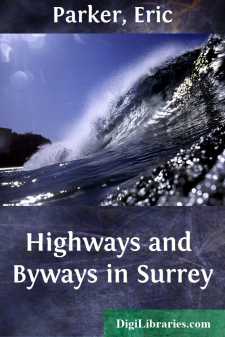Categories
- Antiques & Collectibles 13
- Architecture 36
- Art 48
- Bibles 22
- Biography & Autobiography 813
- Body, Mind & Spirit 142
- Business & Economics 28
- Children's Books 14
- Children's Fiction 11
- Computers 4
- Cooking 94
- Crafts & Hobbies 4
- Drama 346
- Education 46
- Family & Relationships 57
- Fiction 11829
- Games 19
- Gardening 17
- Health & Fitness 34
- History 1377
- House & Home 1
- Humor 147
- Juvenile Fiction 1873
- Juvenile Nonfiction 202
- Language Arts & Disciplines 88
- Law 16
- Literary Collections 686
- Literary Criticism 179
- Mathematics 13
- Medical 41
- Music 40
- Nature 179
- Non-Classifiable 1768
- Performing Arts 7
- Periodicals 1453
- Philosophy 64
- Photography 2
- Poetry 896
- Political Science 203
- Psychology 42
- Reference 154
- Religion 513
- Science 126
- Self-Help 84
- Social Science 81
- Sports & Recreation 34
- Study Aids 3
- Technology & Engineering 59
- Transportation 23
- Travel 463
- True Crime 29
Highways and Byways in Surrey
by: Eric Parker
Description:
Excerpt
CHAPTER I
THE PILGRIMS' WAY
The Pageant of the Road.—Canterbury Pilgrims.—Henry II. barefoot.—Choosing the Road.—Wind on the Hill.—Wine in the Valley.—Pilgrim's Progress.—Shalford Fair.—A doubtful Mile.—Trespassers will be Prosecuted.—With Chaucer from the Tabard.
East and west through the county of Surrey runs the chalk ridge of the North Downs, the great highway of Southern England from the Straits of Dover to Salisbury Plain. Of all English roads, it has carried the longest pageant. It saw the beginnings of English history; for four centuries it was one of the best known highways in Christendom: the vision from its windy heights is one of the widest and most gracious of all visions of woods and fields and hills. By the trackway they made upon the ridge came the worshippers to Stonehenge; Phœnician traders brought bronze to barter for British tin, and the tin was carried in ingots from Devon and Cornwall along the highway to the port of Thanet; Greeks and Gauls came for lead and tin and furs, and the merchants rode by the great Way to bring them. When Cæsar swept through Surrey on his second landing, his legions marched over the Way before he turned north to the Thames. When the Conqueror drove fire and sword through Southern England, he went down to Winchester by the chalk ridge; and when the great lords under the Conqueror and Rufus, Richard de Tonebrige and William de Warenne, built their rival castles, they built them to command the highway; so did Henry of Blois build his castle at Farnham; and so was Guildford Castle built. Of warfare later than Norman days, the Way saw nearly all that went through Surrey. Simon de Montfort and his barons rode fast by the ridge the year before Lewes; they lay at Reading on the twenty-ninth of June, and on the first of July at Reigate. In the wars of the Parliament, Farnham west of the Way saw the siege of an hour; Lord Holland led his little band from Dorking to Reigate and fled back again. Last of the echoes of Stuart battles, Monmouth, after Sedgmoor, was driven through Farnham to lodge for one night of misery and fear at Abbot's Hospital in Guildford.
But the Way has another meaning and other memories. It is as the Pilgrims' Way that it is best known, and as the Pilgrims' Way that it has been written about and tracked and traced and surrounded with legend and story and the haunting melancholy of an old road once used and now half forgotten. The Pilgrims' Way is more than the old Way, for it runs by more than one road. The old Way took its followers along the ridge or just under it, high in the sun and wind where the traders and fighters could see their route clear above the thick woods of the Weald. The Pilgrims' Way lies as often on the low ground as on the hill. But it follows the line of the chalk ridge, and the parallel roads, though here and there it would be difficult to choose between them as to which was most used by travellers, have become vaguely named the Pilgrims' Way, and as the Pilgrims' Way they remain.
Along the Chalk Ridge.—Leith Hill in the Distance.The Way became the Pilgrims' Way in 1174, four years after Thomas à Becket was murdered in Canterbury Cathedral. His tomb in the Cathedral became the second shrine in Christendom, and pilgrims came to it along the old trackway through Surrey, from Farnham east of the Hog's Back along the hills to Canterbury in Kent. Henry the Second, one of the earliest pilgrims of all, made his act of repentance a few days after landing at Southampton from France, on February 8, 1174. Or so legend relates, and adds that he swore to walk barefoot; history is less precise. After Henry the stream of devotees multiplied. Pilgrims landed, like Henry, at Southampton, or between Southampton and Chichester, and came through Winchester or Alton to Farnham; travellers from the West of England joined the foreigners at Winchester, or came to Farnham by the old Harrow Way, another ancient track from Salisbury Plain. Thousands made the journey; more and more followed year by year. At last it was determined to divide the stream. St. Thomas was murdered on December 29, and the great pilgrimage to Canterbury and the return centred round that date. In 1220 pilgrims were given a chance of paying their vows in summer as well as winter....


